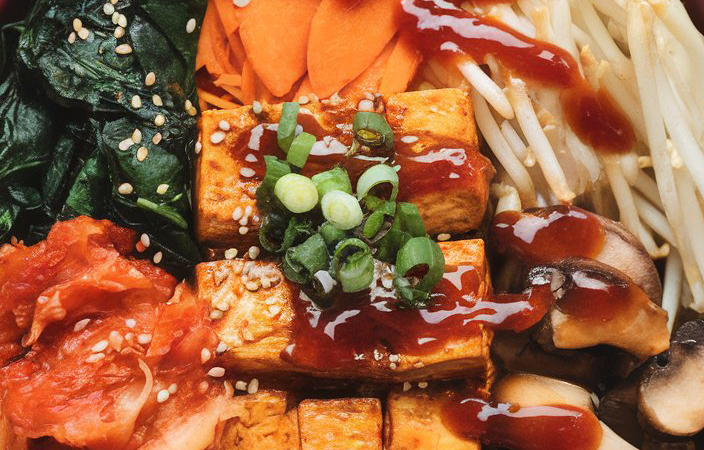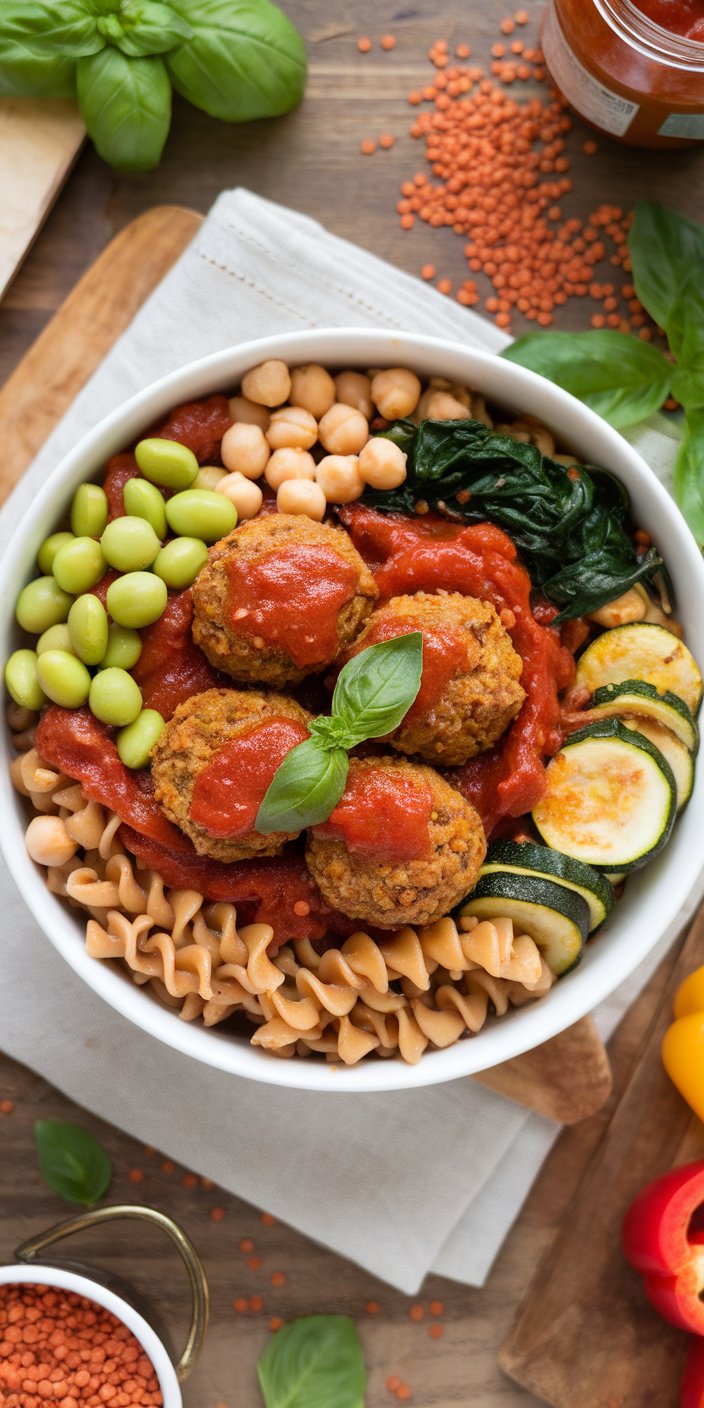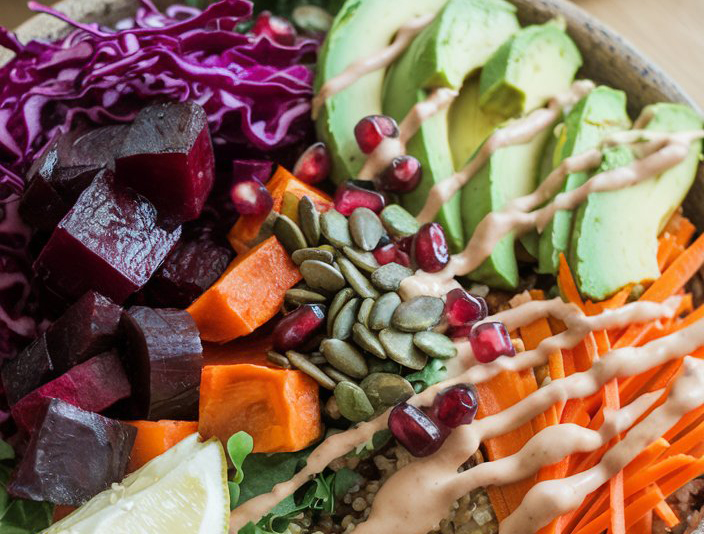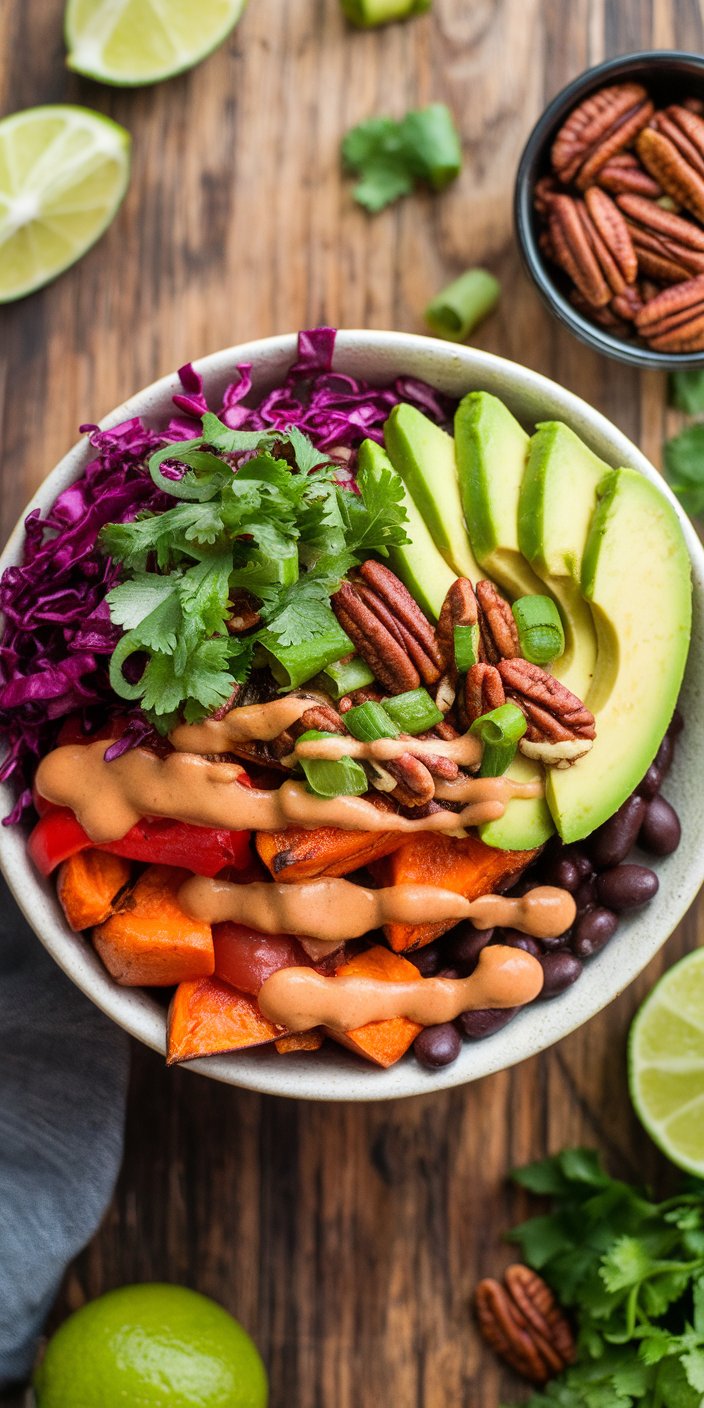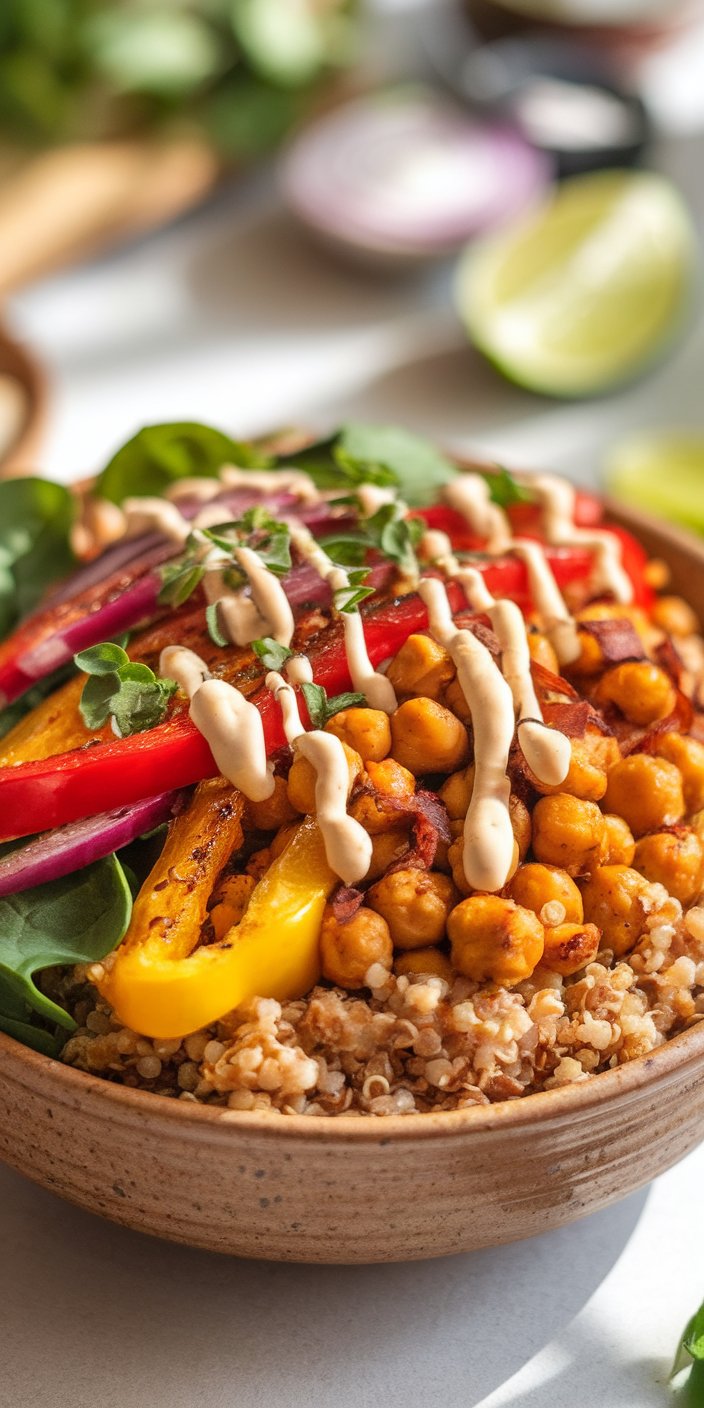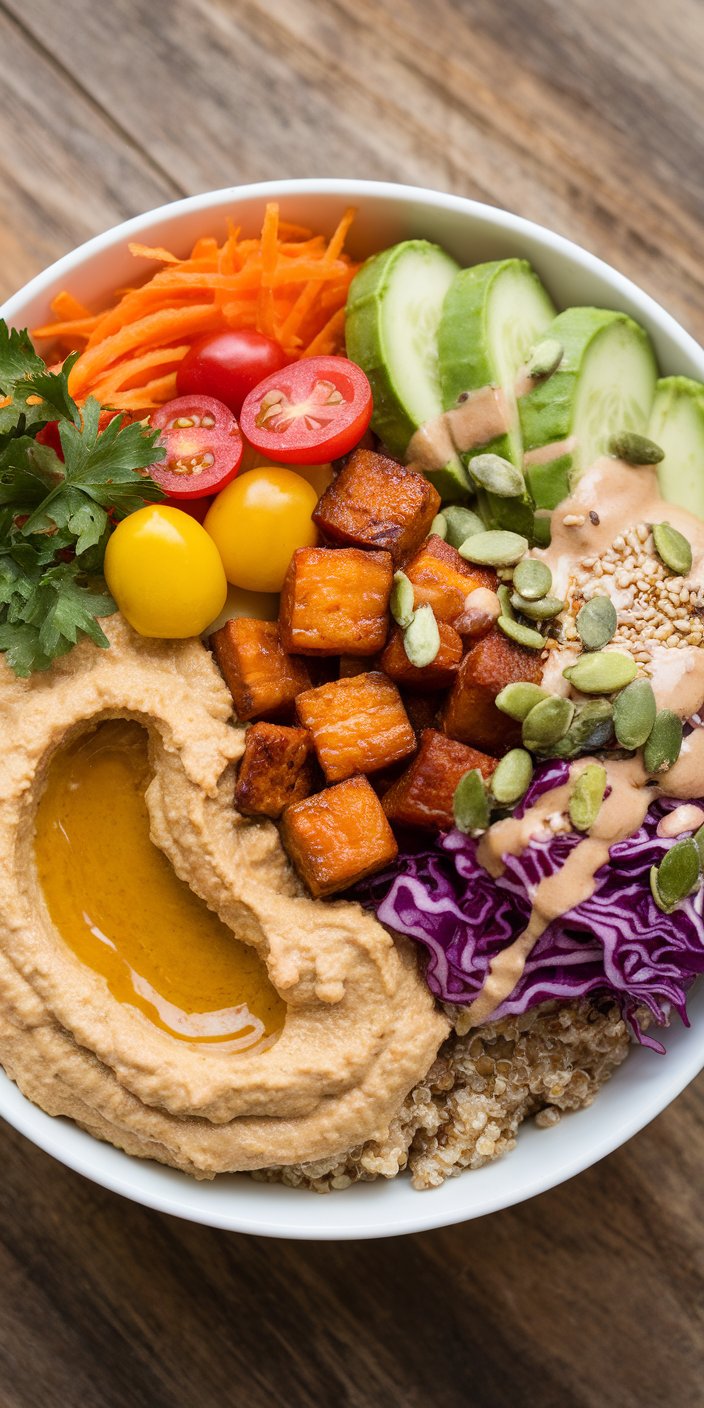Korean Bibimbap Vegan Bowl Recipe
Bring the vibrant flavors of Korea to your kitchen with this vegan twist on the classic Bibimbap. Packed with bold flavors, wholesome ingredients, and eye-catching colors, this dish is as satisfying as it is beautiful.
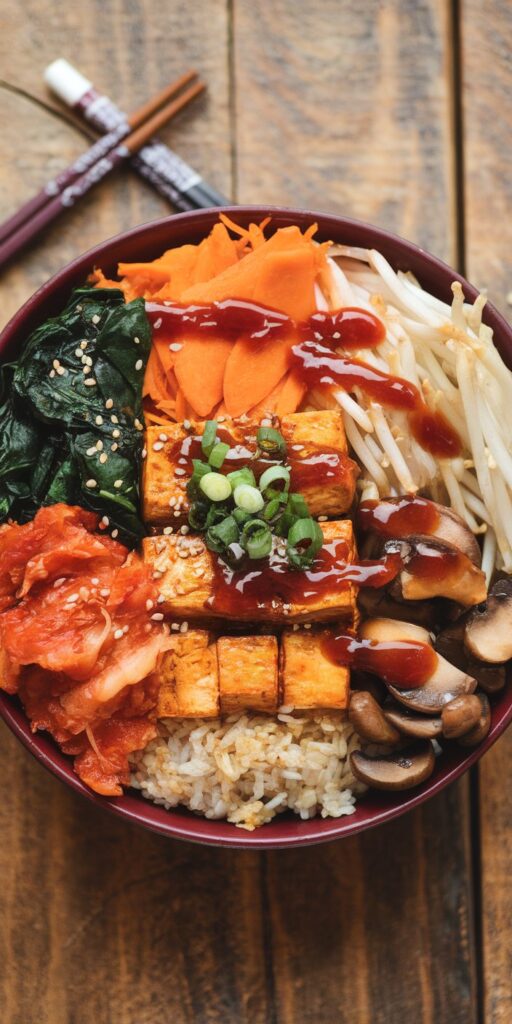
Perfect for lunch or dinner, it’s a healthy meal that’s both nourishing and delicious.
Ingredients
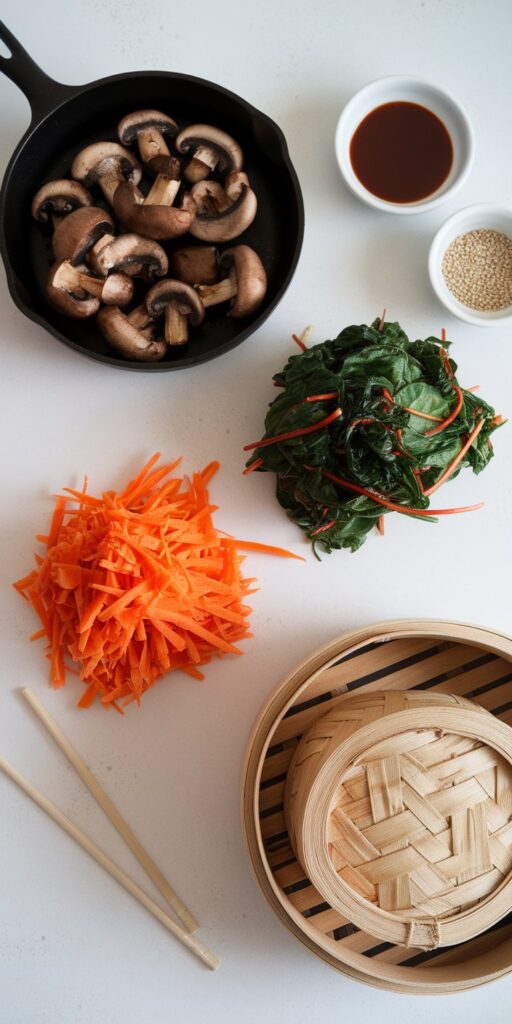
For the Base:
- 2 cups cooked short-grain rice or sushi rice
For the Gochujang-Marinated Tofu:
- 1 block of extra-firm tofu, pressed and sliced
- 2 tbsp gochujang (Korean chili paste)
- 1 tbsp soy sauce
- 1 tbsp sesame oil
- 1 tsp rice vinegar
- 1 tsp maple syrup
For the Veggies:
- 1 cup sautéed spinach
- 1 cup shredded carrots
- 1 cup bean sprouts, lightly steamed
- 1 cup sliced mushrooms, sautéed in sesame oil
For the Extras:
- 1/2 cup kimchi (vegan, if needed)
- 1 tbsp sesame seeds
- 2 green onions, finely sliced
For the Dressing:
- 2 tbsp gochujang
- 1 tbsp soy sauce
- 1 tbsp sesame oil
- 1 tsp rice vinegar
- 1 tsp maple syrup
- 1-2 tbsp water (to thin as needed)
Instructions
1. Cook the Rice:
- Start by thoroughly rinsing the short-grain rice under cold water until the water runs clear. This step removes excess starch and ensures fluffy grains.
- Cook the rice using a rice cooker or stovetop method. For stovetop, use a 1:1.5 ratio of rice to water. Bring to a boil, then lower the heat, cover, and simmer for about 15 minutes. Let it rest for 5 minutes, then fluff with a fork.
- Once cooked, keep the rice warm. Warm rice provides a cohesive base for the toppings and absorbs the flavors better.

2. Marinate and Cook the Tofu:
- Press the tofu to remove excess water. Wrap it in a clean kitchen towel, place a heavy object like a skillet on top, and let it press for 10-15 minutes. This improves the texture and allows it to absorb the marinade fully.
- In a medium bowl, combine gochujang, soy sauce, sesame oil, rice vinegar, and maple syrup to create a flavorful marinade.
- Slice the tofu into even pieces (about 1-inch cubes or rectangles). Toss them in the marinade, ensuring every piece is evenly coated. Let it sit for at least 15 minutes, or up to 1 hour for deeper flavor.
- Heat a non-stick skillet over medium heat. Add the marinated tofu and cook for 3-4 minutes on each side until golden brown and slightly crispy. Remove from heat and set aside.
3. Prepare the Veggies:
- Heat sesame oil in a large skillet over medium heat. Add the sliced mushrooms and cook for 4-5 minutes until they are tender and lightly golden. Set aside.
- In the same skillet, add the spinach with a pinch of salt. Cook for 1-2 minutes until just wilted. Avoid overcooking to maintain a vibrant green color. Set aside.
- Lightly steam the bean sprouts for 1-2 minutes until they are tender but still crisp. Drain and set aside.
- Shred the carrots finely using a box grater or julienne peeler. Keep them raw for a fresh, crunchy element that contrasts with the cooked ingredients.
4. Make the Gochujang Sauce:
- In a small bowl, whisk together gochujang, soy sauce, sesame oil, rice vinegar, and maple syrup. Adjust the sweetness or saltiness to your preference.
- Gradually add water, one tablespoon at a time, to thin the sauce to a pourable consistency. It should be smooth and creamy, but not too runny.
- Taste and adjust flavors as needed. A little extra maple syrup can balance the spice if desired.
5. Assemble the Bowl:
- Begin by adding a generous scoop of warm cooked rice to the bottom of each serving bowl, spreading it evenly.
- Arrange the prepared ingredients in distinct sections over the rice: sautéed spinach, shredded carrots, steamed bean sprouts, sautéed mushrooms, and gochujang-marinated tofu.
- Add a spoonful of vegan kimchi to one section for a tangy and spicy kick. Arrange the toppings with care to create a visually appealing and colorful presentation.
6. Garnish and Serve:
- Drizzle the prepared gochujang sauce generously over the bowl, ensuring it touches all the components for an even flavor distribution.
- Sprinkle sesame seeds liberally over the bowl for a nutty crunch.
- Add finely sliced green onions as a fresh garnish, enhancing the aroma and presentation.
- Serve immediately. Encourage diners to mix all the ingredients together before enjoying to fully experience the harmonious blend of textures and flavors.
Tips
- Protein Alternatives: Substitute tofu with tempeh or seitan for variety. For a whole-food option, try marinated portobello mushrooms.
- Veggie Swaps: Add zucchini ribbons, roasted sweet potatoes, or edamame for additional flavors and textures.
- Adjust Spice Levels: Reduce the amount of gochujang for a milder flavor, or add a pinch of red pepper flakes for extra heat.
- Meal Prep: Store all components separately in airtight containers in the fridge for up to 4 days. Assemble fresh bowls as needed.
- Texture Boost: Add a handful of crispy seaweed snacks or toasted nori strips for an umami-rich crunch.
This vegan Korean Bibimbap Bowl is a celebration of flavors, textures, and wholesome ingredients. It’s an easy way to bring the taste of Korea to your table in a plant-based and nutritious way.
Whether you’re new to Korean cuisine or a seasoned fan, this recipe will delight your taste buds and nourish your soul!

